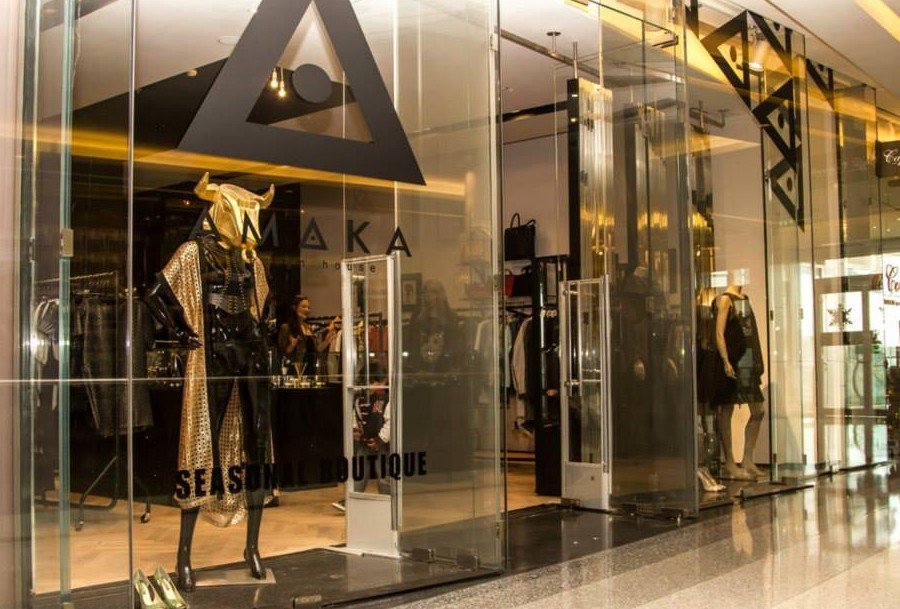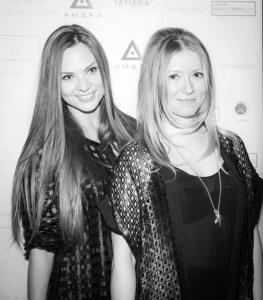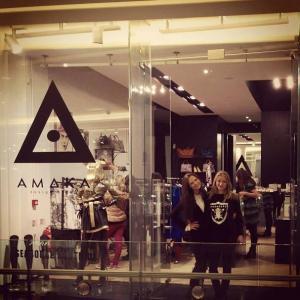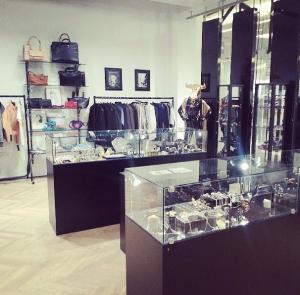Breaking into the fashion industry is extremely difficult, especially for young designers. Two young entrepreneurial minds, Viktoria Naumenko and Marianna Molchanova, were brought together by a popup project in “The Village”, the luxury fashion and lifestyle department of one of the largest urban shopping centres in Europe – Westfield London.
They launched the Amaka Seasonal Boutique, a popup concept store representing fashion designers as well as artists that aim to promote and support up-and-coming talents all over the world.
Viktoria, who moved from Tallinn to London a few years ago to finish her MA in the Central Saint Martins College of Art and Design to devote her future to innovation management, told us their story.
How did you meet and how did you come up with the idea to run a popup shop?
We met in the summer of 2013 at one of the exhibitions for young designers in London. We both have similar backgrounds and interests in design. Talented up-and-coming designers today are in the need to be exposed to a wider audience to develop and sell their products and grow their brand awareness. London as one of the most international and diverse cities with many people constantly looking for something new and unique brought us to the idea that a store with a popup conception would be an excellent start.
Also, at the time I wanted to investigate the popup culture for my final thesis and the opportunity to go behind the scenes and actually run and manage a popup store in one of the most visited shopping centres seemed to be an ideal solution.
What were your first biggest challenges?
The opportunity did not come easy. We were looking for a store space for over three months and the challenge was mostly in the negotiations with the lessors. We were often in a situation where the owner of the space warmly welcomed out idea, but did not want to rent the space for short-term.
But why a popup shop, not a traditional store?
Popup was the best suitable option for many reasons. First of all, we wanted to test our idea and get the experience of retail pros and cons in London, which is famous for different nationalities looking for various unique products but at the same time it’s one of the cities where it’s hard to break into the industry due to high competition.
Secondly, we what we have also discovered is that nowadays we are facing a constant change and customers’ needs and expectations are also constantly changing. As Bauman has described in his book, Liquid Society, today everything is about fast movement and constant change. So such a phenomenon as popup has become so popular due the fact that people get to take part in something extraordinary and unique.
Last but not least, the traditional retail model is changing and popup can be set up and marketed with minimal capital outlay or infrastructure requirement, and it does not require long or expensive tie-in leases. So the risk is smaller.
Who are the most famous designers represented in your shop?
There are more than 30 designers participating in the project from countries both far-flung and near to home. We are lucky to represent the wears of the London Fashion Week participants: Christopher Raeburn – a designer who is known for his creative reinterpretation of military fabrics; a famous deconstructive tailoring master Jean-Pierre Braganza, Copurs London – a label that unites the best of the Middle East and Central Europe styles; luxury fashion brand Velsvoir, specialising in luxury bow ties; Serge DeNimes – a unisex brand by the “Made in Chelsea” star Oliver Proudlock; petroleum jewellery by Niza Huang; Maison Twenty – a brand created by the community of twenty independent artists; an award-winning bespoke jewellery brand, Cardinal of London; Vogue Italy’s Talent 2013 ,Caterina Gatta; Pigeon obsession jewellery collection by Tessa Metcalfe; a truly ethical fur collection by Marita Huurinainen and astonishingly skilful and distinctive handcrafted scarves by Emma Shipley – to name but a few.
Overall, our store is an eclectic mix of very different designers and styles. We have everything from menswear to womenswear and jewellery and the work of various artists.
Have you also planned to offer Estonian designers’ products?
We didn’t represent any Estonian designers, but we are happy to offer our help and share our know-how with Estonian designers as well.
Do you think it’s easier to succeed in London than in Estonia?
I believe London offers more opportunities and challenges than Estonia, especially if you want to enter international markets. It’s definitely hard to break into the market due to high competition, but if you already get your foot in the door, all you need to do is work very hard and connect with the right people to succeed.
I’d say it’s easier to succeed in Estonia as a local market, but if your ambitions are big, you will end up in London, Paris or Milan sooner or later.
According to your experience, what works best for designers in your concept store?
In order to become a great designer, make some sales and create a community who loves your design, it’s not enough to just design clothes. You need to have an opinion, principles, a story and unique ideas why you are doing this. Today people don’t buy designer clothes just because they are cheap or expensive, they buy them because they share the same values with the designer and they love that you carry your values in your products. Your product must add additional value in the eyes of your client who is wearing them. That’s why your clients keep coming back.
What have you learned from this experience?
Our six-month project is coming to an end in May. We have gained a lot of experience in handling critical situations. For example, we had to be ready to set up the entire shop in one week, find good designers, install the shop interior and go through the whole bureaucracy and paperwork of what it takes to manage a shop in a big shopping centre like Westfield London.
After all the hard work I can say that it made me aware of all the risks and challenges of entrepreneurship in the UK. It gave me knowledge and professionalism to lead projects as big in the future. It was also a useful experience because of the contacts we have by now in the industry.
What are your next goals?
We are excited to look for new challenges in the industry. Based on what we have learned, we have gained the know-how and experience, how to promote designers and artists. Already today we are helping many designers to get into the local and international wholesale market. Also, we are organising different events and shows to help designers get feedback from potential clients and grow their sales. We have many interesting ongoing projects and we are open to new collaborations. My personal goal now is to stay in London to grow my potential in this inspiring city.
I
Cover photo: Amaka Seasonal Boutique at Westfield London (photo courtesy of Lithium-UK Photography).






Great article, just one question. Why the qualifier of “Estonian Russians”? Why not just Estonians? We don’t refer to Mesut Özil as a “German Turkish” footballer, or Mo Farah as a “British Somali” athlete.
Because one of the founders originally comes from Russia, the other one from Estonia 🙂
“Estonian-Russian” implies each person is both. “Estonian and Russian” would be more accurate then. You wouldn’t write “Male-Female innovators” but rather “Male and Female”, unless the innovators were trans-gendered.
@query Just to clarify, I am as one of those “Estonian Russians” was really comfortable with such definition even if they both came from Estonia, there is nothing offensive in such qualifier to both nations on my opinion.
@triin_linamagi:disqus thank you for your work and great articles, keep doing!